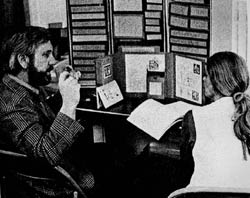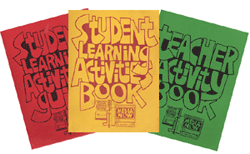Iowa Educators Pioneer Media Now Curriculum
|
|
Innovative high school program built around 50 hands-on 'learning packages'
As far back as pioneer days, Iowans have led the field in education. The first settlers sectioned the land and established one-room schools within a mile or two of most farmsteads. In the 1860s, Iowans chartered the first land-grant institution of higher learning, Iowa State University. Matching Iowa's pioneer spirit, the university's programs are open to all, practical in nature, and available to everyone in the state through extension and outreach.
A century later, Iowa educators again blazed trails in the emerging field of media education with a unique self-directed, module-based curriculum called Media Now.
In the mid-1960s in the small southwest Iowa city of Red Oak, two forward-thinking education entrepreneurs, Bill Horner, a middle school teacher, and Ron Curtis, a K-12 AV specialist, received grant funding to deliver educational audio-visual materials to teachers and classrooms in a multi-county region. The Southwest Iowa Learning Resources Center (LRC) became a precursor of today's area education agencies and served as a community locus for an innovative film study program.
The LRC housed, scheduled, and delivered daily a collection of instructional resources, including 16mm films, slides, filmstrips, learning kits, overhead transparencies, audio tapes, and books to school districts in nine counties. The staff also received grants to develop original curricula, provide teacher training, and offer community outreach.
By 1968, Curtis' experiences coordinating the media collection, working with K-12 teachers, and leading evening film study classes led him to develop an innovative media curriculum for high school students. The community film study classes led Curtis to three primary project collaborators: Drake University film studies professor Russ Cochran, Iowa State University film history professor Dann Perkins, and Mt. Ayr (IA) secondary educator Bill Hohlfeld.
Creating Media Now Through the Iowa Department of Public Instruction, Curtis secured a Title III grant from the United States Office of Education (USOE) under the Elementary and Secondary Education Act (ESEA) to support prototyping, research, evaluation, and dissemination of Media Now, a "first-time" curriculum to introduce high school students to the media world that was exploding around them. It was also designed to familiarize teachers with media issues, equipment and genres so that they would develop more confidence and creativity in the classroom. Media Now had seven modules:
Through the Iowa Department of Public Instruction, Curtis secured a Title III grant from the United States Office of Education (USOE) under the Elementary and Secondary Education Act (ESEA) to support prototyping, research, evaluation, and dissemination of Media Now, a "first-time" curriculum to introduce high school students to the media world that was exploding around them. It was also designed to familiarize teachers with media issues, equipment and genres so that they would develop more confidence and creativity in the classroom. Media Now had seven modules:
- media hardware — how cameras worked and how to operate projection equipment
- media production — basic shots, storyboarding, scriptwriting and editing.
- media genre — characteristics of various genres from film and TV to radio and print.
- media evaluation — keeping a media log and developing criteria for evaluation
- media interpretation — analyzing visuals, advertising and propaganda
- media aesthetics — exploring artistic principles in film, TV and radio
- media presentation — how to present a media message to an audience.
But the centerpiece of Media Now was its 50 individualized learning activity packages —- each one containing everything needed to complete a specific instructional exercise. For example, the package on "Lighting" contained a Styrofoam head plus a book of activities on how to light it for various emotional effects (dramatic, scary, etc.) The "Basic Camera" package included a kit to make your own camera plus a hand viewer to look at your film!

The complete curriculum package included two student books — a Student Learning Activity Guide (SLAG) and a Student Learning Activity Book of background readings (SLAB) plus a resource-filled Teacher Activity Book and a comprehensive Media Dictionary. Through a unique reference system of interweaving questions and color coding, the student and teacher books and the activity packages formed a unique and comprehensive program of individualized or small group study that has never been duplicated anywhere since.
Created to capitalize on the emerging trend toward self-directed education, Media Now helped students understand various aspect of media culture by giving them hands-on opportunities to make their own — to write scripts, take photographs and develop film, record and edit audio tapes, produce films and videos, and evaluate and critique media messages, including propaganda. The course could be used as a semester-long exploration, an entire year's program, or as individual modules within an existing academic content area.
Curriculum design emphasized individualized instruction, performance objectives, and learning by doing. Testing and research validated the curriculum. All 50 activity packages fit neatly into the three large cardboard boxes for permanent placement in any classroom or for transport from site to site within a school or district.
Philip Lewis, in a March 1973 article in Nation's Schools, described Media Now. "Emphasis on self-instruction is the unique part of the Media Now curriculum. Creative and independent-minded students get a bonus with the project-designed 'learning activities packages,' keyed to…topical areas….There are 50 packages in all — essentially self-study guides that let kids do much of the work on their own, in any order and at the rate they choose."
The Project goes National
About the same time Media Now was coming out of Red Oak, a feisty law professor from the University of Iowa - Nicholas Johnson — was named to serve on the Federal Communications Commission (FCC). During his seven-year tenure (1966-1973), Johnson became an outspoken advocate for citizen awareness and involvement with the media. His book, How to Talk Back to Your Television Set, challenged lay people and educators alike to become literate in the language and technology of television. Johnson learned about the Media Now curriculum, supported the work of the LRC, and offered his knowledge of Washington, D.C., to help Curtis and Horner in their efforts to find additional funding for their "visual literacy" work and for dissemination of Media Now from the U.S. Office of Education.
 The Southwest Iowa Learning Resources Center locally manufactured the Media Now curriculum components, creating nearly 500 sets that were sold to schools and school districts throughout the United States, in Canada, and in Israel within the decade of the 1970s. National Dissemination Project Developer-Demonstration grants from the U.S. Office of Education and a grant from the National Endowment for the Arts helped promote the curriculum through demonstration school sites, public presentations, and teacher training.
The Southwest Iowa Learning Resources Center locally manufactured the Media Now curriculum components, creating nearly 500 sets that were sold to schools and school districts throughout the United States, in Canada, and in Israel within the decade of the 1970s. National Dissemination Project Developer-Demonstration grants from the U.S. Office of Education and a grant from the National Endowment for the Arts helped promote the curriculum through demonstration school sites, public presentations, and teacher training.
LRC staff and the Media Now "sales force" offered informational awareness seminars across the United States, presented the curriculum at state and national media and visual literacy conferences, and responded to direct inquiries sparked by word-of-mouth accolades from teachers who participated in formal and informal training sessions at LRC facilities in Red Oak and elsewhere.
In 1973, Media Now received the Educational Pacesetter Award from the President's National Advisory Council on Supplementary Centers and Services. Arthur Ballantine, Council Chair, said the award was made in recognition of the project's success in areas relating to innovativeness, pupil achievement, cost-effectiveness, and program administration. Ballantine noted, "It is a special tribute to your project to have been selected from among the more than 2000 Title III projects in this country and to be considered worthy of replication and adoption by other school systems."
Testimony from a Teacher
By the late 1970s, publicity materials from the LRC highlighted John West, who had been teaching the Media Now course at Roberto Clemente High School in Chicago for three years. West said, "It has rewards like no other kind of teaching because students are like no other students. You've got a bunch of kids who want to be special people, to use their individual creative specialties in writing, music, speaking, acting, and putting sound and vision together to communicate as individuals and as a team. So you hand them a camera, a microphone, recorders, and projectors and try to help them. If you're lucky enough…some of them get it all together in a well-scripted, well-photographed, well-acted, well-produced film or [video]. It's a pretty good feeling.
"If the product is good enough to win a place in a public showcase — whether a movie screen or a broadcast channel — it's the most satisfying and ego-fulfilling credit that either instructor or student could hope for."
 But by the mid-1980s, the LRC had disbanded and Media Now was no longer manufactured. The Media Dictionary was sold separately to an independent publisher. As video replaced 16mm films and digital photography simplified picture-making, the curriculum and its components has gone further out of date with each passing year. Pieces of the package gather dust in school closets, district warehouses and the attics of teachers and staff.
But by the mid-1980s, the LRC had disbanded and Media Now was no longer manufactured. The Media Dictionary was sold separately to an independent publisher. As video replaced 16mm films and digital photography simplified picture-making, the curriculum and its components has gone further out of date with each passing year. Pieces of the package gather dust in school closets, district warehouses and the attics of teachers and staff.
In 2005, an archival set of the Media Now curriculum packages and textbooks/guides found a home at the Center for Media Literacy in Los Angeles, California.
"Media Now was an amazing curriculum," says CML Founder Elizabeth Thoman. "It stands as a testimony to the ingenuity and innovativeness of two extraordinary teachers of the 1960's and 70's and the team they assembled. I can't think of anything else like it anywhere. We are pleased to have recovered this significant stepping stone in the history of media literacy in the USA."



